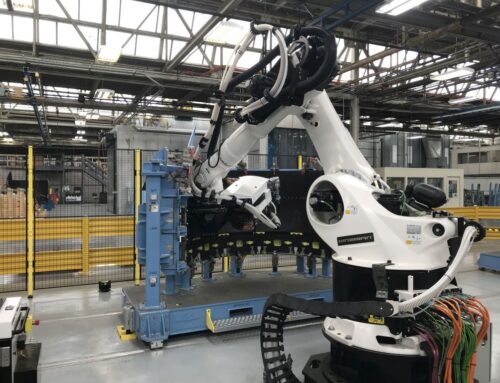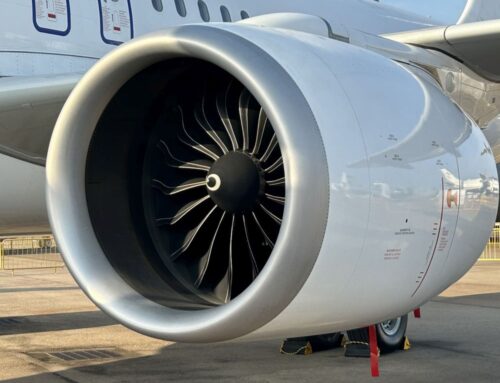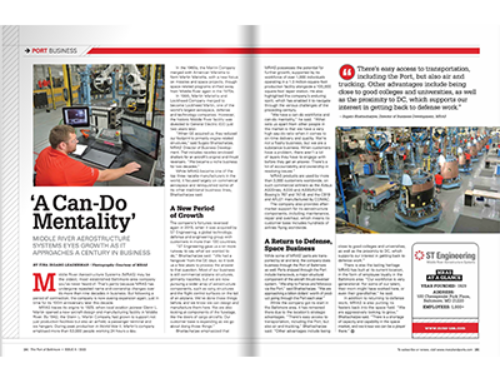
In this group photo, nurses from the Progressive Care Unit at Johns Hopkins Bayview hospital wear the first face shields delivered by MRAS employees for Maryland-area healthcare personnel.
Two employees’ determination to provide caregivers with more comfortable protective equipment during the COVID-19 pandemic has come together with the spirit of innovation – and the support of Middle River Aerostructure Systems (MRAS) management – to create 500 face shields that are now being used in hospitals around the Baltimore region.
MRAS is a subsidiary of ST Engineering, and the effort to produce this PPE (personnel protective equipment) was led by manufacturing engineer Marc Hemling and lean manufacturing leader Andrew Hong – taking into account many of the major problems reported by users of “do it yourself” face shields, including issues with wearability, adjustability and functionality.
The initial motivation came from first-hand input: Hemling’s wife and Hong’s girlfriend are both nurses, with their feedback echoed by dozens of other caregivers at several Maryland-area hospitals. “Instead of trying to create a shield that we could make cheaply and quickly, we decided to make the best shield possible – with comfort, reusability, and nurses’ feedback in mind,” Hemling explained.
A better solution

Face shields are prepared for individual bagging at the MRAS facility by (from left to right) manufacturing engineer Marc Hemling; Amy Dederich of MRAS’ Environmental Health Safety Team; and Jon Belcher, MRAS union relations leader.
Both Hemling and Hong use 3D printers at home, and they applied their knowledge in producing components for the protective shields, while keeping the overall elements as simple and straightforward. The duo’s face shield is much more comfortable than current solutions, allowing for extended use by caregivers in treating patients.
“We saw first-hand that hospitals were providing the cheapest facemask solutions they can get their hands on, which certainly isn’t comfortable – especially when it is being worn 12 hours at a time,” explained Hong. “We knew we could make something better.”
The face shield comprises two procured elements: an elastic headband typically used with wearable sport action cameras; and a thermoplastic visor that was cut and processed at MRAS. The visor is connected to the headband using a 3D-printed plastic mount and attachment knob with steel screw.
Design ingenuity down to the detail

An assembled face shield is shown in this close-up photo. The 3D-printed mount and attachment knob are the orange-colored elements.
The mount is 3D printed in a curved shape to wrap around the wearer’s head. When assembling a face shield unit, this element is bent until completely flat. The visor piece is then installed on three pin-type extensions that are integral to the 3D-printed mount.
After releasing the mount, this component springs back to its original curved shape – and the visor bends along with it, without the need for hot forming or other shaping techniques.
To facilitate the assembly of face shields, the mount’s three pin-type extensions are spaced equal to that of a standard three-hole paper punch. This enables a paper punch to be used in creating mounting holds in the thermoplastic visor, simplifying the production process.
The batch of 500 face shields were delivered in individually-bagged units, complete with instructions for their assembly.
MRAS provides its support

A packaged face shield unit, complete with assembly instructions, is ready for delivery by MRAS employees to Baltimore-area hospitals.
Hemling and Hong successfully pitched their innovative face shield to the MRAS management team led by General Manager and Senior Vice President Frank Dougherty, with the company contributing funding, resources and manpower.
Face shields were produced at the MRAS facility in parallel with Hemling and Hong’s own efforts using their home 3D printers, with the batch of 500 units donated for use at four Baltimore-area hospitals: Mercy Medical Center, Johns Hopkins Hospital, Johns Hopkins Bayview Medical Center and MedStar Harbor Hospital.
The file for 3D printing the face shield mount and attachment knob has been made available free of charge on the internet. “Anyone can download it for not-for-profit production of face shields,” Hemling noted. “This enables anyone who has a 3D printer at home to help caregivers during the pandemic. You don’t need to be a big manufacturing plant to do this.”
In creating the face shields, Hemling and Hong applied the experience gained with their personal 3D printers at home, as well as by operating a 3D printer acquired by MRAS, which has been used to create jigs and fixtures.
Hemling and Hong were assisted by a team effort at MRAS, which included the support of Charlotte McCauley, Fabricator Bonder; Mackia Kanu, Manufacturing Improvement Specialist; and Charles Winterling, Lead Manufacturing Specialist.

A team effort! Packaged face shields prepared and assembled at MRAS are shown by (from left to right) Amy Dederich of MRAS’ Environmental Health Safety Team; manufacturing engineer Marc Hemling; lean manufacturing leader Andrew Hong; and Terry Vernes, the company’s Process Engineering and Composite Operations Director.



